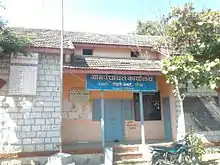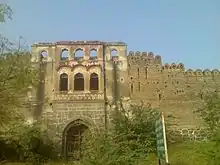Kavathe Yamai
Kavathe Yamai is a village located in Shirur Taluka of the Pune district of Maharashtra state. In earlier times, this village was once located on the banks of the Ghod River (about 5.8 km (3.6 mi) away from its present location). The village later moved to its current location when Maratha General Anand Rao I Pawar, of the Dhar State, built a walled city there. Cultural and historical landmarks include the palace built by the Pawar dynasty in the 18th century, as well as various temples in Hemadpanthi architectural style. The city was once walled, but the expansion of the village borders to allow for increased habitation has caused the surrounding walls, and huge gates to crumble. The village is famous for the Yemai Temple, Fatteshwar Temple, and Sayamba Temple. The temples' land and trust are owned by the Gore Patil family, who were Patil of the village for some time. They manage all economic affairs of the trust. Many followers visit the Kavathe seeking blessings, and to participate in the annual anniversary (Yatra.)

Shri Sudam Ramdas Ichake currently holds a position as sarpanch of village Panchayat. The village comes under Shirur constituency for Loksabha and under Ambegaon constituency for Vidhansabha. Folk art and artiste associated with such as Tamasha drama, Jagaran-Gondhal and Bharud has been flourishing in the village. Poet Bashir Momin Kavathekar[1] and Dholak performer Shri Gangaram Bua are the two prominent folk artiste who had bough laurels with their notable contribution to the Maharashtra's performing art, culture and traditional art form Tamasha. Vithabai Bhau Mang Narayangaonkar's grandfather Shri Narayan Khude who formed his own Tamasha Troupe was also from Kavathe Yamai.[2]
The village has a primary school (run by Zilla Parishad) established in 1866, Higher Secondary School & College (run by Rayat Shikshan Sanstha) and a few more recently founded English medium schools.
Geography and climate
Kavathe is surrounded by Parner Taluka, Khed Taluka, Ambegaon Taluka, and Junnar Taluka. The village is well connected with Manchar, Shirur, and Pune. The Taluka headquarter viz Shirur, is located 25 km (16 mi) away and District headquarter viz Pune is located approximately 65 km (40 mi) away. The village is located in the rain shadow area of the Sahyadris. It has an arid climate, irrigation from the river Ghod, and from wells serve most of the village. Crops include sugar cane, bajra, groundnuts and pomegranates.
Demography
Hinduism (90% of the population) is the largest religion, followed by other religions such as Islam, Buddhism, Jainism. Sects/religions coexist in peaceful manner participating in each other's celebrations/ functions. Major castes are Dhangar and Marathas, both of whom share similar agriculturally-based livelihoods. Common family names include Bhor, Ichake, Kandalkar, Wagdare, Pokale, Sandbhor, Ghode, Yede, Ughade.
History

The village became politically important after the Pawar dynasty constructed a palace and established a walled city around it during the early 18th century. The Yamai temple, Sayamba temple, Datta temple, and Fatteshwar temple are the most prominent temples. Fatteshwar Temple has historical importance as it was built by Anand Rao Pawar after the Marathas defeated Nizam Ul Mulk of Hyderabad. The word Fatte literally means "victory." It is situated on the confluence of a stream locally known as Khar Odha and the river Ghodnadi.
Culture
The beautifully constructed Hemadpanthi style temples include Vithhal Temple, Ganesh Temple, Mahadev Temple, Hanuman Temple. The Yamai temple, Datta temple, and Fatteshwar temple are the most prominent. Yamai temple is located to the west of the village. This village takes its name from its Yamai goddess. Annual festivals/Yatra are organized by villages where many devote from all over Maharashtra participate.
Performing arts
The people in the village are very supportive of the art/literature/theaters. Tamasha artist Mr Gangaram Bua was awarded a national prize for playing the Dholak. He was awarded Vithabai Narayangaonkar Jeevan Gaurav Puraskar by the state government for his service to the field of Tamasha in 2016.
Literature
Bashir Momin Kavathekar - also known as Lokshahir Momin Kavathekar (मोमीन कवठेकर) is a prominent Marathi poet and writer who had also performed as a stage actor during early ’70s and later directed various stage productions for college students in the region. He has been closely associated with Maharashtra’s traditional theater art Tamasha for almost 50 years – supporting the various companies/operators by providing them with popular folk songs like lavani, gan gavlan and short plays/drama called vag natya. He has been mentoring the young generation of artist/performers for last few decades.[3] His use of folkloric narrative styles like Lavanis has helped to popularize his work by making it understandable and accessible across communities. Momin Kavathekar has written more than 4000 folk songs which are often performed by local artists. His collection of songs includes lavani, gan gavlan, poems, devotional songs, and songs on social issues/reforms. He has also written songs for the upcoming Marathi Movie "VIP GADHAV" which features noted comedian Bhau Kadam aka Bhalchandra Kadam as lead actor.[4][5] He has written historical dramas, short stories, street plays, and songs on social reformation and related subjects such as Praudh Saksharta Abhiyan, Gram Swachchta Abhiyan, awareness about AIDS, and ill effects of dowry, and presented/performed them across rural Maharashtra. Some of Kavathekar's short plays have been broadcast on All India Radios Pune Akashwani Kendra. His contribution to Maharashtra's traditional art forms and literature that supports the social causes has earned him recognition such as Vithabai Narayangaonkar Jeevan Gaurav Puraskar,[6] विखे पाटील साहित्य कला गौरव,(Literally: Vikhe Patil Literature Art Honour)[7] ग्रांड सोशल अवार्ड,(literally:Grand Special Award) [8] छोटू जुवेकर पुरस्कार, मुंबई.(Which means: Little Juvekar Award, Mumbai)
The popularity of his lavnis and folk songs among the rural population led a professor of Marathi at Savitribai Phule Pune University to critically study his work within the realm of literature. His personality and literature was chosen for a Ph.D. thesis at Savitribai Phule Pune University in 2010.[9]
See also
References
- "बशीर मोमीन (कवठेकर)", Maharashtra Times, 2-March-2019
- Abp Majha (8 September 2016), माझा कट्टा: लावणी सम्राज्ञी मंगला बनसोडे, retrieved 18 December 2016
- "ग्रामीण भाग कलाकारांची खाण -मोमीन कवठेकर यांचे प्रतिपादन; शिरूरला एकांकिका स्पर्धा", Sakal, Pune, 3 March 2019
- "भाऊ कदम यांचे 'व्हीआयपी गाढव'","Loksatta", 11-Aug-2019
- "भाऊ कदम आता नव्या रंगात अन् नव्या ढंगात येणार तुमच्या समोर!","Maharashtra Kesari". 6-Aug-2019
- "आयुष्यभराच्या निरपेक्ष सेवेचा गौरव! लोकशाहीर बशीर मोमीन यांच्या भावना" , Saamana, Published on 1 March 2019
- "पद्मश्री विखे पाटील साहित्य पुरस्कार जाहीर"(Literrally:Padma Shri Vikhe Patil Literary Award Announced) , Maharashtra Times, Published on 11-Aug-2014
- " समाजहित साधणारेच खरे 'हिरो' -जॅकी श्रॉफ", Prabhat, Pune, 3 November 2011.
- "बहुआयामी साहित्यिक मोमीन कवठेकर", Punya Nagari, Pune, 13 November 2010.